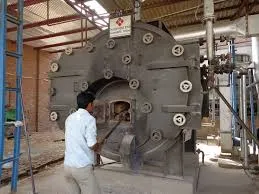
Sep . 15, 2024 00:22 Back to list
simple steam boiler diagram
The Simple Steam Boiler An Overview
A steam boiler is a critical component of many industrial processes and systems, designed to generate steam by heating water. Understanding the basic components of a simple steam boiler diagram can help elucidate how this essential machinery operates and is structured.
At its core, a simple steam boiler consists of several key elements that work in harmony to produce steam efficiently. These components typically include a boiler shell, a furnace, a heat exchanger, a steam drum, and various auxiliary systems such as feedwater and fuel supply systems.
1. Boiler Shell and Furnace The outer casing of the boiler, known as the boiler shell, houses all internal components. Inside this shell is the furnace, where fuel is burned to produce heat. The fuel can be natural gas, oil, coal, or biomass, depending on the boiler's design and application. The combustion of fuel in the furnace generates hot gases, which then transfer heat to the water within the boiler.
2. Heat Exchange Process As the hot gases travel through the boiler, they transfer their heat to the water, causing it to boil and convert into steam. The heat exchanger plays a crucial role in this process, maximizing the heat transfer between the flue gases and the water. The most common type of heat exchanger used in simple steam boilers is a fire-tube design, where hot gases flow through tubes surrounded by water. This setup not only increases efficiency but also facilitates a rapid steam generation process.
simple steam boiler diagram

3. Steam Drum The steam drum is a vital component that serves as a reservoir for the steam produced in the boiler. As water is heated and turns to steam, it rises to the top of the steam drum, where it is collected and separated from any residual water. This separation is crucial, as it ensures that only dry steam is sent to the systems requiring it, such as turbines or heating systems. The steam drum also allows for the monitoring of steam quality and pressure levels.
4. Feedwater System To maintain a continuous steam generation process, a feedwater system is essential. This system supplies water to the boiler, replacing the water that has been converted to steam. The feedwater is typically preheated before entering the boiler, which enhances efficiency and helps to prevent thermal shock to the system. A feedwater pump, often driven by electricity, delivers the water at the required pressure.
5. Safety and Control Systems Safety is paramount in steam boiler operation, given the high pressures and temperatures involved. Simple steam boiler diagrams often illustrate various safety features such as pressure relief valves, water level indicators, and safety shutdown systems. These controls ensure the boiler operates within safe parameters, preventing incidents such as explosions or overheating.
In conclusion, a simple steam boiler operates as an intricate system designed to harness heat energy efficiently for steam generation. By understanding the components represented in a boiler diagram — from the furnace to the steam drum — one can appreciate the engineering behind this essential technology. The efficient operation of a steam boiler is critical in various applications, including power generation, heating systems, and industrial processes, making it an invaluable asset in modern industry.
-
High-Efficiency Commercial Oil Fired Steam Boiler for Industry
NewsJul.30,2025
-
High-Efficiency Biomass Fired Thermal Oil Boiler Solutions
NewsJul.30,2025
-
High Efficiency Gas Fired Thermal Oil Boiler for Industrial Heating
NewsJul.29,2025
-
High-Efficiency Gas Fired Hot Water Boiler for Sale – Reliable & Affordable
NewsJul.29,2025
-
High Efficiency Biomass Fired Hot Water Boiler for Industrial and Commercial Use
NewsJul.29,2025
-
High-Efficiency Biomass Fired Hot Water Boiler for Industrial Use
NewsJul.28,2025
Related PRODUCTS






















